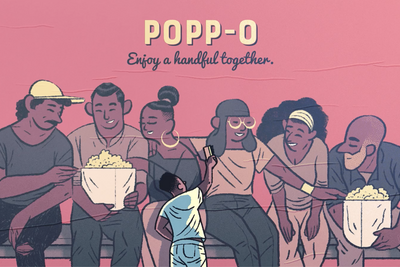Marketing May 3, 2022
For Brands, Perfection Is Out and Authenticity Is In
“It helps you seem more trustworthy and enjoyable, like a friend who is going to give you advice on what to buy.”
Michael Meier
As our lives move increasingly online, the ways marketers interact with us are evolving as well. The increasing adoption of AI is helping companies serve up more relevant ads—while deepening concerns about customer data. Brands are also realizing the benefits of coming across to customers as more fun and more personal than they have in the past.
What can we make of the new web-marketing landscape, and how might consumer interactions be transformed?
Jacob Teeny, an assistant professor of marketing at the Kellogg School, spoke with Kellogg Insight about advances in ad personalization, the ways tech companies are rethinking their privacy policies, and the rise of authenticity.
This interview has been edited for length and clarity.
Kellogg Insight: Which current trends are you most closely following in the digital marketing space? How do you see those trends influencing the broader marketing landscape?
Jake Teeny: These days, I’ve become interested in people’s concerns about privacy.
Privacy is a little paradoxical, because while people say they’re concerned about the privacy of their data, most never do anything about it. Researchers attribute this partly to an evolutionary predisposition. When we lived in smaller groups, we had to be very concerned about our social standing, because we could be kicked out of the group, which could result in death. Nowadays, we still have the vestiges of that, even if the consequences of a bad reputation aren’t as terrible as they used to be. It’s this leftover effect of our evolutionary psychology that hasn’t quite adapted to the widespread pervasiveness of data today.
However, another important part to this “privacy paradox” is that some very fundamental websites leave us little choice to give over details if we want to use them.
This is changing somewhat, as companies like Apple and Google change some of the tools they use to track people. In fact, I was talking with a former marketing executive at Apple, and I asked him, “Why are you guys pushing for privacy? This doesn’t seem from the research to matter too much in terms of changing user behavior.” He said, “To be honest, it was a totally internal decision. We thought, this is an unhealthy way for consumer data to be treated, and we wanted to take a stand.”
Now, of course, Apple has definitely emphasized privacy a fair bit in its advertising, so I’m sure there’s a little bit more than just consumer well-being that they had in mind.
But whatever the reason, it’s going to make it a little more challenging for people to be tracked and for advertisers then to make money or personalize their ads, even though we’re now in the age of personalization.
Insight: How representative is Apple’s pro-consumer-well-being stance? Is it your view that many companies are trying to bolster their reputations and gain consumers’ trust?
Teeny: Not everyone is taking such an outward stance on privacy, as many companies benefit from access to that data. But I do think this question ties to another broad trend we’re seeing, particularly in online marketing, which is trying to develop a sense of authenticity as a brand. Pretty much every brand has to stand for something today. One way you can do that is by trying to take an authentic stand on an issue, whether it is fair labor practices or sustainability or in the case of Apple, privacy, in order to make yourself come across as legit.
Insight: If I’m a brand, what can I do to develop that sense of authenticity beyond just saying, “Yes, I stand for this social issue?” What concrete steps can I take with my online audiences to attract them with a transparent and coherent sense of what I stand for?
Teeny: Well, there’s some recent research to suggest that live videos or disappearing videos on social media are perceived by audiences as a bit more authentic.
But brands can also tell stories. I think there’s a big push towards storytelling now, not only because it helps to cut through the clutter of online advertising, but also because when you tell a story, it feels more authentic. It makes you seem more like a person and less like a third-party disconnected body. It helps you seem more trustworthy and enjoyable, like a friend who is going to give you advice on what to buy.
Insight: That sounds like brands—whether they are selling soap or soda—are thinking a lot about how to make customers feel.
Teeny: Yes, feelings are very important in marketing! In advertising, we often talk about “laddering” ads. For example, when introducing a product, you first describe its features, then you can “ladder up” to the functional benefits of those features, then to the emotional benefits of those functions, and then finally to the product’s higher-order purpose. But today, I think we see a lot more brands spending less time in that functional stage and more in that emotional stage, just because there are so many different products and markets out there that serve a similar function. You have to distinguish or differentiate yourself in some way right away.
In psychology, there’s a phenomenon called the pratfall effect where essentially introducing a small character flaw makes you more likable, because people can’t relate to you when you’re just all shiny and perfect.
I think we’re seeing that with brands, where they’re being more open with their mistakes, which seems like a consequence of the ever-watching eye of social media. It’s a way to build realness, by being a little more off the cuff.
Insight: What factors do you feel are complicating brands’ ability to strive for authenticity? Are there regulatory or industry standards that are forcing marketers to adjust or companies to rethink?
Introducing a small character flaw makes you more likable, because people can’t relate to you when you’re just all shiny and perfect.
— Jacob Teeny
Teeny: Well, there’s a history in the U.S. and elsewhere of advertisers being manipulative. As consumers, we know marketers are going to try to tell us whatever we want to hear.
I think that was a big issue with ad personalization a few years ago. A lot of people didn’t like tailored advertisements at first. They felt like, “oh, you’re tapping into my data and trying to manipulate me with what I’d like.” Now, about 70 percent of consumers prefer personalized ads. They’re like, “if you’re going to show me an ad, at least show me something that I’m actually interested in.”
Insight: Is there a risk of companies overplaying their hand on that specificity?
Teeny: Well as I said earlier, at first, any form of personalization was offensive. Now, a moderate amount is okay, but anything too much is bad. For example, there is consistent finding that using data that people think should be totally inaccessible, such as your bank transactions or financial statements, to personalize an ad really sets people off. Something like, “We noticed you make 30 grand a year. Here’s our special.” People really don’t like that.
But it’ll probably get to the point one day where that’s okay, too. It’s all about our expectations. Once companies have a foot in the door, gradual increases are more acceptable.
Insight: Right now, personalization feels reactionary. I buy a pair of shoes and for the next six months I get sneaker ads everywhere on all my social-media channels. In what ways are companies looking to become more predictive about this on their end, so that they can become more relevant to the customer?
Teeny: The issue you raise about redundant targeting is one that is prolific throughout the marketing industry, and it’s really an issue of bad AI. The reason repurchase behavior is so prioritized now is because that’s what marketers have been able to intuitively—and even statistically—identify as a strong precursor of what people will buy again.
I think we’re going to see better forms of targeting as AI gets better and more widespread. Ultimately, more sophisticated algorithms are going to allow people to be much sharper and much clearer in the types of marketing and analytic tools they use. They will find factors that you might not have expected that can strongly predict a personalized sale.
Fred Schmalz is the business and art editor of Kellogg Insight.



